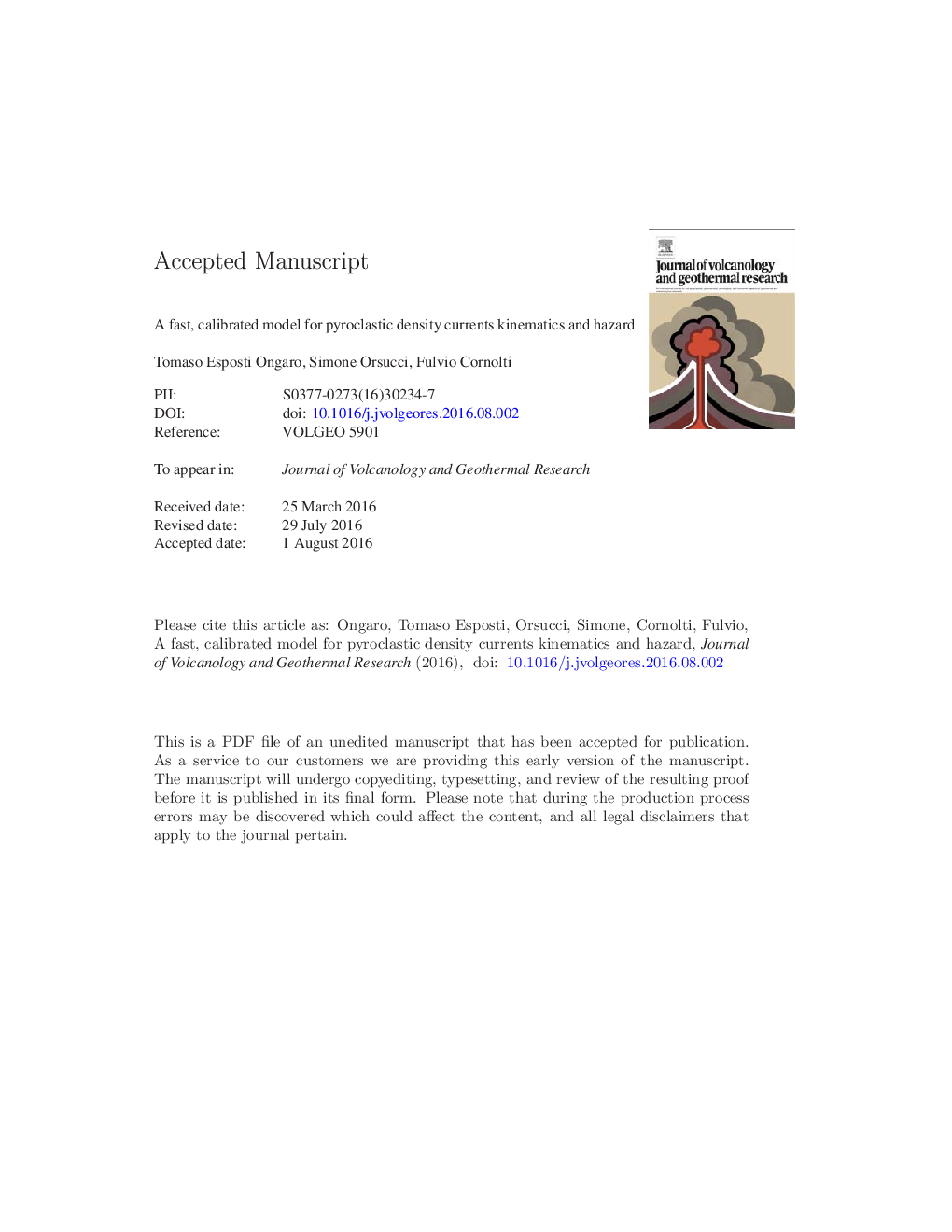| کد مقاله | کد نشریه | سال انتشار | مقاله انگلیسی | نسخه تمام متن |
|---|---|---|---|---|
| 5783773 | 1638295 | 2016 | 50 صفحه PDF | دانلود رایگان |
عنوان انگلیسی مقاله ISI
A fast, calibrated model for pyroclastic density currents kinematics and hazard
دانلود مقاله + سفارش ترجمه
دانلود مقاله ISI انگلیسی
رایگان برای ایرانیان
کلمات کلیدی
موضوعات مرتبط
مهندسی و علوم پایه
علوم زمین و سیارات
ژئوشیمی و پترولوژی
پیش نمایش صفحه اول مقاله

چکیده انگلیسی
Multiphase flow models represent valuable tools for the study of the complex, non-equilibrium dynamics of pyroclastic density currents. Particle sedimentation, flow stratification and rheological changes, depending on the flow regime, interaction with topographic obstacles, turbulent air entrainment, buoyancy reversal, and other complex features of pyroclastic currents can be simulated in two and three dimensions, by exploiting efficient numerical solvers and the improved computational capability of modern supercomputers. However, numerical simulations of polydisperse gas-particle mixtures are quite computationally expensive, so that their use in hazard assessment studies (where there is the need of evaluating the probability of hazardous actions over hundreds of possible scenarios) is still challenging. To this aim, a simplified integral (box) model can be used, under the appropriate hypotheses, to describe the kinematics of pyroclastic density currents over a flat topography, their scaling properties and their depositional features. In this work, multiphase flow simulations are used to evaluate integral model approximations, to calibrate its free parameters and to assess the influence of the input data on the results. Two-dimensional numerical simulations describe the generation and decoupling of a dense, basal layer (formed by progressive particle sedimentation) from the dilute transport system. In the Boussinesq regime (i.e., for solid mass fractions below about 0.1), the current Froude number (i.e., the ratio between the current inertia and buoyancy) does not strongly depend on initial conditions and it is consistent to that measured in laboratory experiments (i.e., between 1.05 and 1.2). For higher density ratios (solid mass fraction in the range 0.1-0.9) but still in a relatively dilute regime (particle volume fraction lower than 0.01), numerical simulations demonstrate that the box model is still applicable, but the Froude number depends on the reduced gravity. When the box model is opportunely calibrated with the numerical simulation results, the prediction of the flow runout is fairly accurate and the model predicts a rapid, non-linear decay of the flow kinetic energy (or dynamic pressure) with the distance from the source. The capability of PDC to overcome topographic obstacles can thus be analysed in the framework of the energy-conoid approach, in which the predicted kinetic energy of the flow front is compared with the potential energy jump associated with the elevated topography to derive a condition for blocking. Model results show that, although preferable to the energy-cone, the energy-conoid approach still has some serious limitations, mostly associated with the behaviour of the flow head. Implications of these outcomes are discussed in the context of probabilistic hazard assessment studies, in which a calibrated box model can be used as a fast pyroclastic density current emulator for Monte Carlo simulations.
ناشر
Database: Elsevier - ScienceDirect (ساینس دایرکت)
Journal: Journal of Volcanology and Geothermal Research - Volume 327, 15 November 2016, Pages 257-272
Journal: Journal of Volcanology and Geothermal Research - Volume 327, 15 November 2016, Pages 257-272
نویسندگان
Tomaso Esposti Ongaro, Simone Orsucci, Fulvio Cornolti,